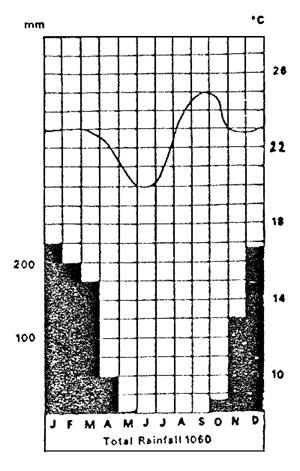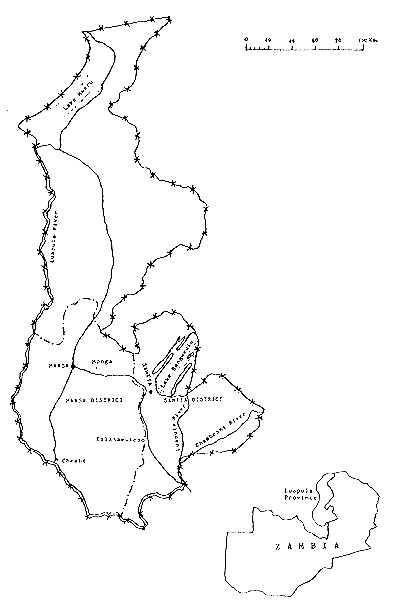Experience in Asia in particular, and more recently in Africa, indicates that farming systems based on the integration of crops, livestock and fish production can contribute significantly to food supply and the income of farmers.
Rice-cum-fish culture is carried out by stocking rice fields with fingerlings in order to obtain a fish crop in addition to rice, the main crop. This method ensures a more economic utilization of land, since it produces both rice and fish. Very little extra labour is required to take care of fish, as it can be attended to at the same time as the rice. Labour for weeding is saved since fish feeds on weeds. Further, rice yield is increased because of fewer insects, better mineralization and distribution of nutrients, improved soil aeration and increased organic fertilization.
As with other kinds of integrated farming, the basic advantage of rice-cum-fish farming is that waste products (or rather by-products) from one system such as organic fertilizer or weeds can be used as inputs for another system. The total farm output is increased beyond the level that would be possible with separate production systems. A major benefit of rice-cum-fish farming is that inputs to the various subsystems which comprise the farming system tend to come from within the farm. Moreover, fish efficiently converts low-grade feeds into high quality animal protein and can thereby be kept alive on maintenance diets without loss of condition, leading to a high degree of flexibility in harvesting strategies1. In this way a high-value and nutritious source of food can be obtained with a minimum of effort and external inputs.
Rice-cum-fish farming systems are also highly flexible as a variety of fertilizers and supplementary feed substances can be utilized. Similarly, a wide range of levels of management, from extensive to highly intensive, can be successfully applied. Obviously, the higher the grades of fertilizer and feeds and the more intensive the level of management applied, the higher the yield of fish. What is important for the small-scale fish farmer, however, is that increases in yield can be achieved without resorting to costly manufactured inputs.
Additionally, the two crops cultivated on the same field increase the farmer's income, ensuring a higher return on his investment.
Finally, rice-cum-fish farming helps spread the farmer's risks (biological and economic). If a disease breaks out or a crop is damaged because of drought or excessive rains, a rice-cum-fish farming system may save the farmer from a total loss of income.
To sum up, the potential advantages of rice-cum-fish farming are:
Although the principle of integrated agriculture-aquaculture such as rice-cum-fish culture appears to have a high potential in Africa, it has not yet been applied on a wide scale. There are several reasons for this.
In many African countries, there are serious constraints to aquaculture and integrated farming development, such as adverse environmental conditions for fish growth (aridity, high altitude/low temperature); shifting agriculture, which takes up much farm land; seasonal labour shortages; lack of interest in fish husbandry; competition from capture fisheries in fish markets; social attitudes etc.2, combined with a lack of assessment of the economic, physical, institutional, structural and other investment components required to sustain aquaculture development.
There are health implications as well. Constructing an extra water body increases the risk of contracting human water-borne diseases such as bilharzia or malaria. However, in a situation where the farmer already has a rice field, stocking it with fish is likely to mean fewer snails and mosquitoes, the animals which carry these diseases.
Finally, rice-cum-fish farming is more complex than a single system. It requires more knowledge from the farmer and better management, and the failure of one subsystem can adversely affect the other.
ALCOM initiated rice-cum-fish trials in Luapula Province, Zambia, during the rainy season 1992/93. The purpose of the trials was to assess the effect of an integrated farming system on the yield of the two crops. Additionally, the profitability and hence the economic viability of rice-cum-fish farming would be evaluated. Luapula Province was chosen for the trial because of its agro-climatic conditions (suitable for both rice and fish production). Further, the presence of the ALCOM Aquaculturist based in Mansa could facilitate the logistics of the trials. These are the first trials on rice-cum-fish farming which have been reported in Zambia.
Situated in Zambia's high-rainfall zone, Luapula Province is one of the agro-climatic areas which receive enough rain to support both upland and lowland paddy rice production3.
Temperatures and rainfall by month, Mansa.

Source: Vegetation and Climate, Survey Department, Lusaka, 1992.
Introduced to the province two to three decades ago, rice was grown along Luapula and Chambeshi rivers and on the shores of Lake Mweru and Lake Bangweulu. Today rice covers less than one per cent of the cultivated area. Maize, cassava, finger millet, groundnuts, mixed beans and sorghum are more important in the province4. Rice has only recently become part of the diet of some farmers, and is mostly marketed in towns and consumed by higher-income groups. Nevertheless, it ranked second to maize5 as a cash crop in 1985/86. More than half of the rice production is concentrated in Mansa District. The reasons rice production has not made more headway are lack of seeds, the price the farmers can get for the product, and traditional preferences.
Luapula Province is one of the main fish producing provinces of Zambia, harvesting 17,027 metric tonnes or 31% of the national production in 19926. Two-thirds of the fish production is exported out of the province, primarily to Lusaka, the Copperbelt and Zaire. People are used to eating fish, and because of the capture fishery -- especially from the lakes -- fish farmers face strong competition when marketing their products in towns. In most villages, however, the demand for fish is high as it is cheaper than other kinds of relish.
4Department of Agriculture, Luapula Province, 1992.
Map of Luapula Province, Zambia
